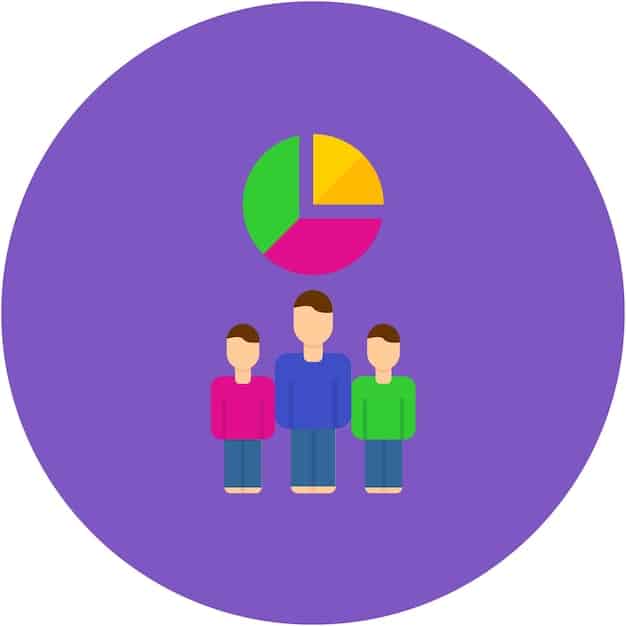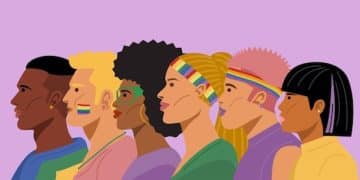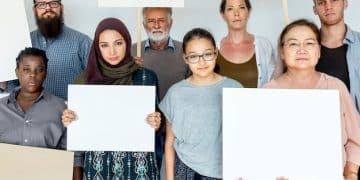Exploring Intersectionality: Race, Gender, and Class in Social Justice

Exploring the Intersectionality of Social Justice Issues: How do Race, Gender, and Class Intersect in Current Debates? examines the complex ways these identities overlap, creating unique experiences of discrimination and privilege. Understanding this intersectionality is crucial for effective social justice advocacy and policy-making.
In today’s complex social landscape, understanding the interplay between different forms of oppression is more critical than ever. The concept of Exploring the Intersectionality of Social Justice Issues: How do Race, Gender, and Class Intersect in Current Debates? provides a framework for examining how various social and political identities combine to create unique modes of discrimination and privilege.
This article aims to delve into these intricate relationships, shedding light on how race, gender, and class intersect in contemporary discussions and shape experiences across different communities.
Understanding the Core of Intersectionality
At its core, intersectionality is a theoretical framework that examines how various social and political identities, such as race, gender, class, sexual orientation, and disability, combine to create unique experiences of discrimination and privilege. It moves beyond single-axis analyses to consider the multifaceted nature of identity and its impact on individual lives.
The Origins of Intersectionality
The term was coined by Kimberlé Crenshaw in 1989 to address the limitations of mainstream feminism, which often overlooked the experiences of women of color. Crenshaw noted that black women faced discrimination that was distinct from both racism and sexism, requiring a framework that acknowledged the intersection of these identities.
Why Intersectionality Matters
Understanding intersectionality allows us to recognize that individuals can face multiple forms of oppression simultaneously. This recognition is vital for crafting inclusive policies and advocacy strategies that address the root causes of social injustice.
- Highlighting unique experiences of marginalized groups.
- Promoting more inclusive and equitable policies.
- Encouraging deeper empathy and understanding.
Ultimately, understanding the core of intersectionality allows us to understand how different power structures affect the most marginalised members of society.

Exploring the Intersection of Race and Gender
The intersection of race and gender is a critical area within intersectional analysis. Women of color, for example, often experience discrimination that is distinct from that faced by white women or men of color. This unique form of oppression requires targeted attention and advocacy.
Historical Context
Historically, women of color have been marginalized within both feminist and civil rights movements. Their experiences have often been overlooked or subsumed under the dominant narratives of white women or men of color, as they try **Exploring the Intersectionality of Social Justice Issues: How do Race, Gender, and Class Intersect in Current Debates?**.
Contemporary Issues
Today, the intersection of race and gender manifests in various forms, including wage gaps, healthcare disparities, and representation in leadership positions. Women of color are often paid less than their white male counterparts and face systemic barriers to advancement. In other cases, women of colour are not believed or heard, especially if they are in a room dominated by white males.
- Wage inequality for women of color.
- Disparities in healthcare access and quality.
- Underrepresentation in leadership roles across sectors.
Recognizing and addressing these issues requires an intersectional approach that considers the specific challenges faced by those at the intersection of race and gender. To achieve parity and equality, specific issues need to be addressed that affect both groups.
The Impact of Class on Race and Gender
Class intersects with race and gender to create additional layers of complexity. Low-income individuals from marginalized racial and gender groups often face compounded disadvantages, limiting their access to education, healthcare, and economic opportunities.
Economic Disparities
Economic inequalities disproportionately affect people of color and women. Systemic barriers, such as discriminatory hiring practices and unequal pay, contribute to persistent class divisions and exacerbate the challenges faced by marginalized communities.
Access to Education
Class also plays a significant role in access to quality education. Low-income students often attend under-resourced schools, limiting their academic opportunities and perpetuating cycles of poverty. This educational disparity further compounds the effects of race and gender discrimination.
Overall, the effects on race and gender affect education, pay and lifestyle. By **Exploring the Intersectionality of Social Justice Issues: How do Race, Gender, and Class Intersect in Current Debates?** it is possible to more accurately tackle underlying issues.
- Limited access to quality education for low-income students.
- Discriminatory hiring practices affecting marginalized groups.
- Unequal pay contributing to persistent class divisions.
Intersectionality in Current Debates
Intersectionality is increasingly relevant in contemporary discussions about social justice issues. From debates about affirmative action to discussions surrounding police brutality, an intersectional lens can provide valuable insights and inform more effective solutions and by **Exploring the Intersectionality of Social Justice Issues: How do Race, Gender, and Class Intersect in Current Debates?** deeper insights can be achieved.
Affirmative Action
Affirmative action policies aim to address historical and ongoing discrimination by providing opportunities to underrepresented groups. However, debates about affirmative action often fail to consider the complex ways in which race, gender, and class intersect.
Police Brutality
The issue of police brutality highlights the intersection of race and class, as marginalized communities are disproportionately affected by law enforcement violence. Understanding these dynamics is crucial for advocating for police reform and accountability.

Intersectionality can therefore enable more effective policing, whilst creating a more equitable experience when it comes to affirmative action.
- Inclusion of intersectional perspectives in affirmative action debates.
- Addressing the root causes of police brutality through an intersectional lens.
- Developing comprehensive social justice strategies.
Challenges and Criticisms of Intersectionality
Despite its value, intersectionality is not without its challenges and criticisms. Some argue that it can lead to excessive fragmentation, making it difficult to build broad coalitions for social change. Others worry that it prioritizes identity politics over universal principles of justice and these need to be taken into account when **Exploring the Intersectionality of Social Justice Issues: How do Race, Gender, and Class Intersect in Current Debates?**.
Fragmentation Concerns
Critics argue that focusing too much on the unique experiences of different identity groups can create divisions and undermine solidarity. However, proponents of intersectionality maintain that acknowledging difference is essential for building true unity.
Identity Politics
Some view intersectionality as an extension of identity politics, which they believe diverts attention from broader structural issues. However, intersectionality seeks to address both individual experiences and systemic oppression.
Intersectionality ultimately has far more benefits than issues, even those raised should be considered in future thought leadership to ensure continued progression and equitable outcome for all.
- Navigating concerns about fragmentation in social justice movements.
- Balancing identity politics with broader structural analyses.
- Addressing criticisms while upholding the core principles.
Strategies for Advancing Intersectional Justice
Advancing intersectional justice requires a multi-faceted approach that combines individual awareness, institutional reform, and policy changes. Understanding how different forms of oppression interlock is the key to effective advocacy and social change.
Promoting Awareness
Educating individuals about intersectionality is a vital step in fostering empathy and understanding. This can involve workshops, training programs, and educational resources that highlight the experiences of marginalized groups.
Institutional Reform
Institutions can implement policies and practices that promote equity and inclusion. This can include diversity and inclusion initiatives, affirmative action programs, and measures to address pay disparities.
By promoting awareness and creating institutional reform, the issue of justice is at the forefront and gives those most marginalized a better platform.
- Raising awareness about intersectionality through education and training.
- Implementing institutional policies that promote equity and inclusion.
- Advocating for policy changes that address systemic oppression.
| Key Point | Brief Description |
|---|---|
| 💡 Core Concept | Examines how race, gender, and class create unique discriminations. |
| ⚖️ Social Justice | Addresses inequalities considering overlapping identities. |
| 🎯 Effective Policies | Crafting inclusive policies aware of identity intersections. |
| 🤝 Coalitions | Building broader unity by acknowledging differences. |
Frequently Asked Questions
Intersectionality is a framework analyzing how race, gender, and class create unique forms of discrimination and privilege. It’s crucial for inclusive social justice.
Class adds complexity by compounding disadvantages for low-income people in marginalized groups, limiting access to vital resources and opportunities.
It is important because it considers unique challenges faced by individuals with overlapping identities, leading to more inclusive and effective solutions.
Challenges include concerns about fragmentation in social justice movements and balancing focus on identity with broader structural issues.
It can be advanced by first promoting awareness through education, then implementing institutional policies that encourage inclusion for marginalized people.
Conclusion
In conclusion, recognizing and addressing the intersectionality of race, gender, and class is essential for advancing social justice. This framework allows for a deeper understanding of the unique challenges faced by marginalized groups and promotes the development of more effective and inclusive policies and strategies.
By embracing an intersectional approach we can contribute to a more equitable and just society for people whatever their background, and this can also address Exploring the Intersectionality of Social Justice Issues: How do Race, Gender, and Class Intersect in Current Debates?





